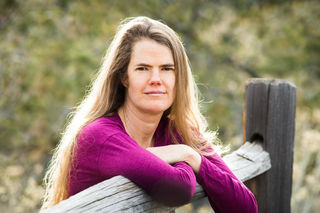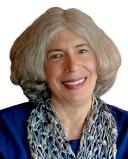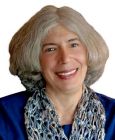Health
Chronic Fatigue Syndrome: A Striking Story
One woman’s fascinating journey to regain her health.
Posted June 6, 2017

Julie Rehmeyer’s new book, Through the Shadowlands: A Science Writer’s Odyssey into an Illness Science Doesn’t Understand, is an excellent read even if your life has not been affected by Chronic Fatigue Syndrome. This is because Julie is a great writer, and so the book stands on its own as a page-turning memoir. That said, it’s so much more. Julie describes getting sick and being diagnosed with Chronic Fatigue Syndrome (the preferred name today is Myalgic Encephalomyelitis or ME/CFS). This sets her on a journey to find help from a medical community that has little understanding of this illness and whose doctors often treat their patients with disdain. Not deterred, she calls upon her scientific background to investigate possible causes and to experiment with different treatments. She doesn’t quit until she finds the culprit that turned her life upside down: toxic mold allergy.
Chronic Fatigue Syndrome is a label that’s applied to many different conditions. I’ve been diagnosed with it since I failed to recover from what appeared to be a routine viral infection in 2001. Julie has the same diagnosis, but it’s clear to me that we suffer from different illnesses. Our symptoms don’t match. In fact, in the sixteen years since my diagnosis, I’ve yet to encounter anyone whose symptoms match mine. In addition, our experiences in discovering what helps and what doesn’t differs (except for the importance of pacing).
We won’t get answers to the mystery surrounding this illness until more money is allocated for research. If that were to happen, I’m confident we’d discover that ME/CFS is an overbroad term that encompasses several subsets of illnesses, each with a set of causes that indicate the need for different treatment approaches.
Julie is so fortunate to have found the cause of her illness. In her book, you’ll accompany her from wellness to illness and back to wellness. It’s a journey well worth taking because Julie is a great storyteller, and reading her prose is such a pleasure. I also want to say how thrilled I am for her and how impressed I am that, through grit and determination, she discovered the key to regaining her health.
My heartfelt thanks to Tiffany Lee Brown for crafting these questions for Julie. Tiffany is a writer-artist who suffers from fibromyalgia and mold illness. She is also an editor at Plazm, a print magazine of art, design, literature, and dissent made in Portland since 1991 (https://magazine.plazm.com).
And now, here’s the interview with Julie.
1. Everyone has their own journey through illness, grief, and injury. Briefly, how would you describe your journey from being so sick you couldn’t turn over in bed, diagnosed with Chronic Fatigue Syndrome, to being healthy and mobile most of the time?
My illness came on gradually, rather than with a sudden flu-like illness as happens for many patients. It was a period of enormous stress for me: I had a very demanding job, I was building a strawbale house with my own hands, and my husband was going through a very serious illness of his own. So initially, I figured, “Who wouldn’t be exhausted?’ At the same time, it seemed awfully extreme—I remember, for example, trailing my hand along the wall as I walked to the bathroom, afraid I might pass out. Still, I expected that when I finished the house and got my life in order, I’d be fine.
I wasn’t. I felt somewhat better over time, but I continued to have a lot of trouble with exercise. My body felt like an old nag, and I had to kick it cruelly to get it to move. Worse, the day after exercise, I often felt terrible. That was quite unlike me—before building the house, I’d run a marathon.
Then in 2006, I woke up one morning barely able to walk. I staggered, and it felt both like my legs weighed 300 pounds apiece and like the nerve signals were getting scrambled as they traveled from my brain to my legs. I had been having increasing problems with exercise and exhaustion over the previous year, but nothing like that.
I went to a neurologist, and he diagnosed me with chronic fatigue syndrome. But for him, that clearly meant, “Please get out of my office. I have nothing to offer you.” No tests, no treatments, no other doctors, nothing.
I visited a zillion doctors after that, but I gradually came to the hard conclusion that none of them had much to offer. Since I’m a science writer, I dug into the scientific literature myself, but I was shocked by how weak it was, filled with small studies that hadn’t been replicated. I wasn’t sure that any of the studies pointed to anything real. I concluded that neither medicine nor science had anything to offer me.
So I started experimenting on myself, and I discovered some very helpful strategies. The most important of them was pacing myself — I learned to stop the moment I thought, “I’m a little tired.” If I continued my activity for even a couple more minutes, I paid. I also discovered a truly bizarre treatment, one I still don’t understand: If I went swimming in the middle of one of my paralysis episodes, it went away for the rest of the day. It didn’t work prophylactically, unfortunately, but it did cure me temporarily once I got crippled.
Such strategies allowed me a reasonable level of function for about four years, albeit with bad days or bad weeks. But then in late 2010, I suffered a severe setback, and I spent a year bedbound about half the time, sometimes unable even to turn over in bed. At that point, I went to the top specialists in the world, but their treatments ultimately didn’t make much difference.
It was a terrifying time. I was in a relationship that was crumbling under the weight of my illness, and I concluded I had to leave. I moved back home to Santa Fe, after spending six years in the Bay area, and I was thrilled to be home but my relationships in Santa Fe had withered during my absence. I was barely able to work and was running out of money. I couldn’t really even take care of myself. I had little family to turn to. I was 39, and about the only future I could imagine for myself was residence in a Medicaid-funded nursing home.
So when I heard about a group of patients who believed they had dramatically improved by taking extreme steps to avoid mold, I was riveted. I was also extremely skeptical: I had no evidence I’d ever gotten a serious mold exposure, and also, what I knew of the science suggested that mold could cause respiratory problems, but not neurological ones like mine. Still, I was desperate enough to listen, and ultimately to run an experiment following the advice of the “moldies,” as they called themselves: I went to Death Valley for two weeks with none of my own belongings. I was on just enough of an upswing that I hoped I could pull it off.
The moldies predicted that when I got home, my own home and stuff would make me dramatically sick, and that would prove that mold was my problem. And indeed, as it turned out, 30 seconds at home was enough to cripple me.
I ended up getting rid of nearly all of my belongings and moving to a different house, and I had a nearly unbelievable improvement. A week after I got back, I was able to climb a 350-foot hill, which I hadn’t been able to do for a year. I took a picture of the grand view from up there and sent it to all my friends, with the subject line, “Oh. My. God.”
2. Mold illness forces patients to let go of a lot—not just metaphorically. You had to leave behind your house, your city, a relationship… and you’ve had to get rid of possessions repeatedly: clothes, computers, books. What has this process taught you?
Before I went to Death Valley, I told friends that I felt like I was going to the desert to die. I expected to be breathing at the end of the trip, but I couldn’t keep going the way I had, working so hard to keep everything together in spite of my illness. It was too hard. I was done.
And while I was there, I felt utterly stripped of life as I’d known it. I was miles from another human being, with just my dog Frances for company, even without my own belongings.
I discovered an incredible freedom in that. All my life, I’d been driven by a restless ambition, a feeling that I needed to make a success of my life. In Death Valley, that drive suddenly seemed absurd, way beyond my capacity. So much effort, I thought. I quit! Just taking one breath after another, managing to heat up my food and wash my dishes, occasionally sweeping the sand out of the tent—that felt like success enough for me. I was astonished to find that a gentle gratitude lay underneath, all the time, like a drum beat, like my own heartbeat. With all my assumed obligations removed, life seemed unimaginably spacious. Just being alive was a thrill, a blessing, a tiny miracle beyond my expectation or control. Anything I managed to accomplish above that was a gift.
When I got home and discovered that the mold hypothesis was true for me, I had to get rid of nearly everything I owned. But I found that surprisingly easy at that point. I got such a dramatic demonstration that avoiding mold was likely to help that my stuff felt trivial by comparison.
3. Many of us with chronic illness are told that it’s “all in our heads.” This can seem like a medical insult, a dismissive way to look at serious physical illness. On the other hand, through emotional, mental, and spiritual practices, many of us improve our lives and sometimes even our symptoms. How do you hold these apparent contradictions and make peace with them?
My mother was a Christian Scientist, so I grew up steeped in the idea that our minds strongly influence the functioning of our bodies. I’m certainly not a Christian Scientist myself, but I don’t believe in this division of mind and body. That whole model strikes me as deeply unscientific. It makes no sense to imagine our minds floating freely outside our bodies, occasionally screwing up and creating illness. The mind and body aren’t just connected, they’re aspects of the same thing, heads and tails, yin and yang, utterly inextricable.
Dealing with illness skillfully, I thought, required analyzing that yin- yang relationship in a nuanced way. Psychology and physiology weren’t opponents in a winner-take-all game. They were partners in a dance. And it was my job to help them move to the music with more connection and grace.
I used psychological approaches to improve my health in many different ways: I thought about my immediate experience in a way that kept me from feeling victimized and helped me create richness and meaning in my life; I revisited old trauma to see if there were ways to shift my relationship to it and perhaps improve my physical health as a result; I worked to calm my nervous system’s response to exposure. I also consistently acted from the belief that diligent attention to one’s internal feelings and attitudes is the best place to start in solving a problem, allowing me to act more powerfully in the world and sometimes opening the doors to change in ways I couldn’t predict.
But it was also scary to open myself to psychological approaches in the context of an illness that has been “psychologized,” causing unimaginable harm to patients. I feared that if I allowed any crack in the imagined door separating mind from body, I (and the entire illness) would get shoved through it, locked onto the wacko side.
4. Finally, what single piece of advice would you offer to patients like yourself?
Poorly understood illnesses like ME/CFS are pushed into the shadow in our culture. I’m thinking of shadow in the Jungian sense: Jung suggested that as individuals, we tend to shove the aspects of ourselves we’re uncomfortable with to the corners of our awareness. He argued that in doing so, we lock away a kind of energy and vitality, and that if we shine a light into those dark corners and rediscover those parts of ourselves we’ve locked away, that energy can be liberated.
I think the same thing is going on at a societal level with poorly understood illnesses: The idea of being sick without knowing what’s going on is terribly frightening, so people tend to push it away by pathologizing the sick. Of course, that approach is no longer an option when you become sick yourself.
Early on, I assumed that I’d be able to find clear medical answers that would pull me out of the shadowlands of illness. Over time, though, I recognized that I had no choice but to take up residence in that dark country.
So my advice to my fellow patients is to recognize that they are doing important work in living in those shadows. Coping with illness eats up unbelievable amounts of life energy, and it often feels like that energy is simply wasted. But I believe that by simply being who you are, while living with the stupid, awful, terrible disease that plagues you, you are bringing light into these shadows. And in doing so, you are liberating energy for society as a whole.
***
Julie Rehmeyer is the author of Through the Shadowlands: A Science Writer’s Odyssey into an Illness Science Doesn’t Understand. She is also a contributing editor to Discover and has been published in the New York Times, Washington Post, O Magazine, Wired, and many other publications.
Toni is the author of three books: How to Be Sick: A Buddhist-Inspired Guide for the Chronically Ill and Their Caregivers (Second Edition) 2018, How to Wake Up: A Buddhist-Inspired Guide to Navigating Joy and Sorrow, and How to Live Well with Chronic Pain and Illness. Visit www.tonibernhard.com for more information and buying options.




